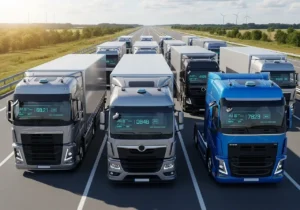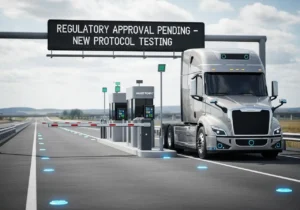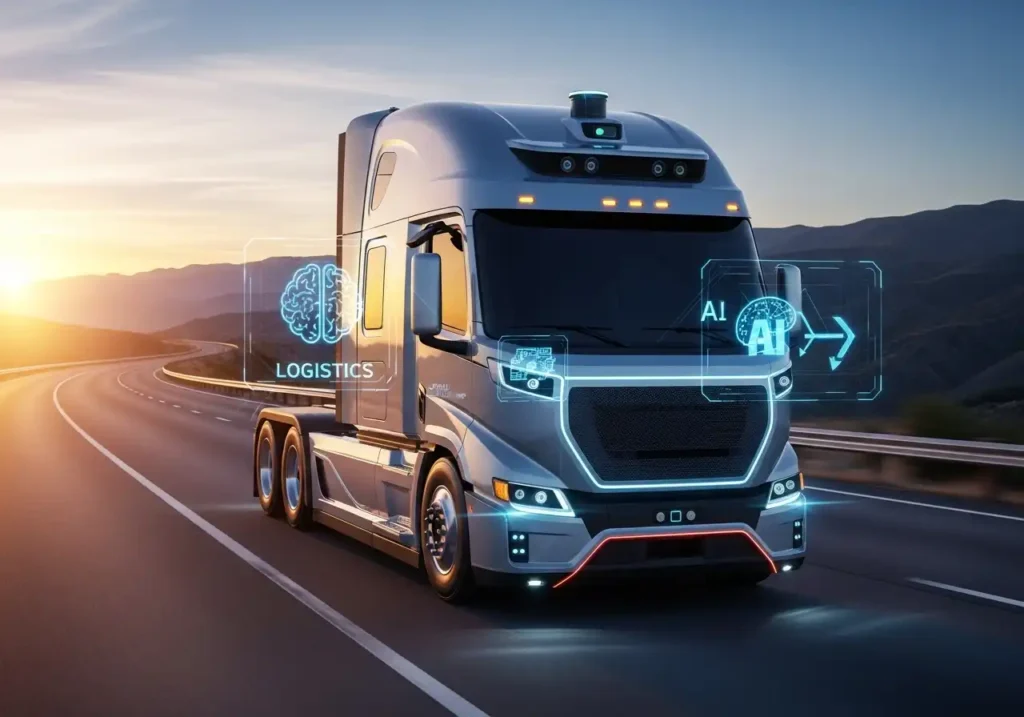The trucking industry is undergoing a significant transformation in 2025, fueled by advancements in artificial intelligence (AI) and autonomous vehicle technology. Once a futuristic concept, self-driving trucks are now a reality, poised to revolutionize freight logistics. These AI-powered trucks promise increased efficiency, reduced costs, and enhanced safety. In this blog post, we’ll explore how autonomous vehicles are reshaping the freight logistics industry in 2025, the benefits they bring, the challenges that remain, and what the future holds for AI-driven trucking.
The Rise of Autonomous Trucks
 Autonomous trucks are equipped with advanced AI systems that enable them to operate without human intervention. These vehicles rely on a combination of sensors, cameras, radar, and machine learning algorithms to navigate roads, detect obstacles, and make real-time decisions. Over the past few years, companies like Aurora Innovation, TuSimple, and Waymo have made significant strides in developing autonomous trucking technologies. By 2025, self-driving trucks are becoming a common sight on highways, moving goods across long distances without the need for a human driver behind the wheel.
Autonomous trucks are equipped with advanced AI systems that enable them to operate without human intervention. These vehicles rely on a combination of sensors, cameras, radar, and machine learning algorithms to navigate roads, detect obstacles, and make real-time decisions. Over the past few years, companies like Aurora Innovation, TuSimple, and Waymo have made significant strides in developing autonomous trucking technologies. By 2025, self-driving trucks are becoming a common sight on highways, moving goods across long distances without the need for a human driver behind the wheel.
These trucks are built to handle various tasks, from navigating highways to avoiding collisions and ensuring safe driving practices. Using data from their sensors and AI systems, they make decisions faster and with greater precision than human drivers, which could drastically reduce accidents caused by human error, improve road safety, and ultimately save lives.
Benefits to Freight Logistics
The integration of autonomous trucks into freight logistics offers several advantages, from enhancing operational efficiency to improving safety and sustainability. Here are the key benefits:
- Increased Efficiency: Autonomous trucks can optimize routes and adjust driving speeds based on real-time traffic conditions, reducing fuel consumption and delivery times. This increased efficiency could lead to a substantial decrease in shipping costs for businesses, benefiting both shippers and consumers alike.
- Cost Reduction: One of the biggest advantages of autonomous trucking is the potential for cost savings. With AI-powered trucks able to operate 24/7 without needing rest breaks or sleep, they can increase fleet utilization and decrease idle time. Additionally, AI can minimize human error, potentially reducing costs related to accidents, insurance, and repairs.
- Enhanced Safety: Self-driving trucks are designed to eliminate common causes of accidents, such as fatigue, distraction, and impaired driving. The AI systems on board these trucks continuously monitor their environment and make quick decisions to avoid collisions, improving safety standards on the road. AI-driven trucks can also follow safety protocols more rigorously than human drivers, adhering to speed limits and braking patterns, which helps minimize the risk of accidents.
- Sustainability: Many autonomous trucks are designed with sustainability in mind. By optimizing routes and reducing idle time, these trucks can help reduce carbon emissions, contributing to a cleaner, greener transportation industry. Additionally, autonomous trucks paired with electric vehicles (EVs) can further improve the environmental footprint of freight logistics, making transportation more eco-friendly.
Challenges and Considerations
 Despite the many benefits, the widespread adoption of autonomous trucks in freight logistics is not without challenges. Here are some of the key hurdles that the industry faces:
Despite the many benefits, the widespread adoption of autonomous trucks in freight logistics is not without challenges. Here are some of the key hurdles that the industry faces:
- Regulatory Hurdles: One of the biggest barriers to autonomous trucking is the lack of uniform regulations. Different states in the U.S. have varying laws regarding autonomous vehicles, and there is still a need for federal policies to ensure safe integration of these trucks on public roads. The regulatory landscape must evolve to accommodate the complexities of autonomous trucking, ensuring that these vehicles can operate safely and legally across state lines.
- Public Perception: Many people still harbor concerns about autonomous vehicles, particularly regarding their safety and reliability. The trucking industry needs to work on educating the public and building trust in self-driving technology. Additionally, some people worry about job displacement for truck drivers, as self-driving trucks could potentially reduce the need for human drivers. Although AI-powered trucks may create new jobs in technology and vehicle maintenance, there is a need for thoughtful conversations about workforce transitions.
- Infrastructure Needs: To fully support autonomous trucking, improvements to the existing infrastructure are necessary. Highways and roads must be equipped with technology that allows for communication between autonomous vehicles and traffic systems. Additionally, autonomous trucks require a reliable and accurate mapping system to navigate their environment safely. Infrastructure upgrades will play a crucial role in ensuring that these vehicles can operate efficiently and safely.
Current Adoption and Industry Trends
As of 2025, several companies are already making strides in integrating autonomous trucks into their operations. TuSimple, for example, has successfully completed several long-haul trucking missions with driverless vehicles, and Aurora Innovation has partnered with major logistics companies to test autonomous freight solutions. Additionally, logistics giants like UPS and DHL are exploring the potential of self-driving trucks to optimize their supply chains and improve delivery times.
One notable trend in 2025 is the growing interest in electric autonomous trucks. Companies like Tesla, Rivian, and Nikola are pushing the boundaries of electric vehicle technology, and many are integrating AI to create electric self-driving trucks. These EV trucks not only offer the benefits of automation but also contribute to sustainability efforts in freight logistics, reducing the carbon footprint of the transportation industry.
The Future Outlook
The future of trucking is increasingly intertwined with AI and autonomous vehicles. While there are still obstacles to overcome, the rapid advancements in self-driving technology suggest that autonomous trucks will soon become a standard part of freight logistics. In the next decade, AI-driven trucks could transform the trucking industry, improving operational efficiency, reducing costs, and enhancing safety on the roads. As regulatory frameworks catch up and technology continues to advance, autonomous trucks are expected to play a pivotal role in the future of transportation.
Conclusion
AI-driven trucking is no longer a futuristic vision; it’s an emerging reality that is reshaping freight logistics in 2025. The integration of autonomous vehicles in trucking promises significant benefits, including increased efficiency, reduced costs, improved safety, and enhanced sustainability. While challenges remain, the rapid pace of innovation in AI and autonomous vehicles indicates that the trucking industry is on the brink of a major transformation. As we move toward a future dominated by automation and AI, the possibilities for freight logistics are vast, and the opportunities are endless for those who embrace this technological shift.

